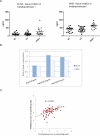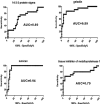Multiplex targeted proteomic assay for biomarker detection in plasma: a pancreatic cancer biomarker case study
- PMID: 22316387
- PMCID: PMC3292708
- DOI: 10.1021/pr201117w
Multiplex targeted proteomic assay for biomarker detection in plasma: a pancreatic cancer biomarker case study
Abstract
Biomarkers are most frequently proteins that are measured in the blood. Their development largely relies on antibody creation to test the protein candidate performance in blood samples of diseased versus nondiseased patients. The creation of such antibody assays has been a bottleneck in biomarker progress due to the cost, extensive time, and effort required to complete the task. Targeted proteomics is an emerging technology that is playing an increasingly important role to facilitate disease biomarker development. In this study, we applied a SRM-based targeted proteomics platform to directly detect candidate biomarker proteins in plasma to evaluate their clinical utility for pancreatic cancer detection. The characterization of these protein candidates used a clinically well-characterized cohort that included plasma samples from patients with pancreatic cancer, chronic pancreatitis, and healthy age-matched controls. Three of the five candidate proteins, including gelsolin, lumican, and tissue inhibitor of metalloproteinase 1, demonstrated an AUC value greater than 0.75 in distinguishing pancreatic cancer from the controls. In addition, we provide an analysis of the reproducibility, accuracy, and robustness of the SRM-based proteomics platform. This information addresses important technical issues that could aid in the adoption of the targeted proteomics platform for practical clinical utility.
Figures






References
-
- Jemal A, Siegel R, Ward E, Murray T, Xu J, Smigal C, Thun MJ. Cancer statistics, 2006. CA Cancer J.Clin. 2006;56:106–30. - PubMed
-
- Brand R. The diagnosis of pancreatic cancer. Cancer J. 2001;7:287–97. - PubMed
-
- Grote T, Logsdon CD. Progress on molecular markers of pancreatic cancer. Curr.Opin.Gastroenterol. 2007;23:508–14. - PubMed
-
- Harsha HC, Kandasamy K, Ranganathan P, Rani S, Ramabadran S, Gollapudi S, Balakrishnan L, Dwivedi SB, Telikicherla D, Selvan LD, Goel R, Mathivanan S, Marimuthu A, Kashyap M, Vizza RF, Mayer RJ, Decaprio JA, Srivastava S, Hanash SM, Hruban RH, Pandey A. A compendium of potential biomarkers of pancreatic cancer. PLoS.Med. 2009;6:e1000046. - PMC - PubMed
-
- Ranganathan P, Harsha HC, Pandey A. Molecular alterations in exocrine neoplasms of the pancreas. Arch.Pathol.Lab Med. 2009;133:405–12. - PubMed
Publication types
MeSH terms
Substances
Grants and funding
- R21 CA161575/CA/NCI NIH HHS/United States
- R21 CA149772/CA/NCI NIH HHS/United States
- R01DK081368/DK/NIDDK NIH HHS/United States
- R01 DK081368/DK/NIDDK NIH HHS/United States
- R21CA161575/CA/NCI NIH HHS/United States
- K07 CA116296/CA/NCI NIH HHS/United States
- K25CA137222/CA/NCI NIH HHS/United States
- K25 CA137222/CA/NCI NIH HHS/United States
- P30 CA015704/CA/NCI NIH HHS/United States
- R21CA149772/CA/NCI NIH HHS/United States
- R01 CA107209/CA/NCI NIH HHS/United States
- R01CA107209/CA/NCI NIH HHS/United States
- K07CA116296/CA/NCI NIH HHS/United States
LinkOut - more resources
Full Text Sources
Other Literature Sources
Medical
Research Materials
Miscellaneous

